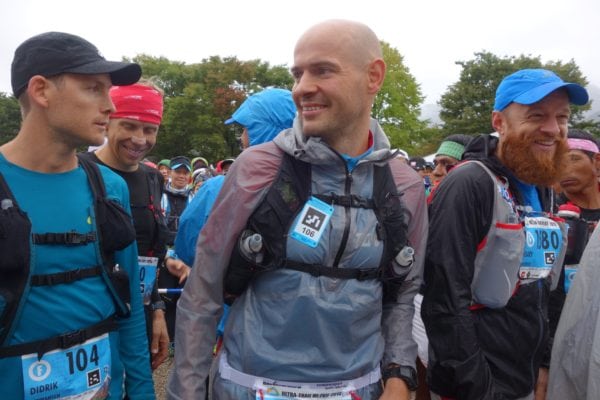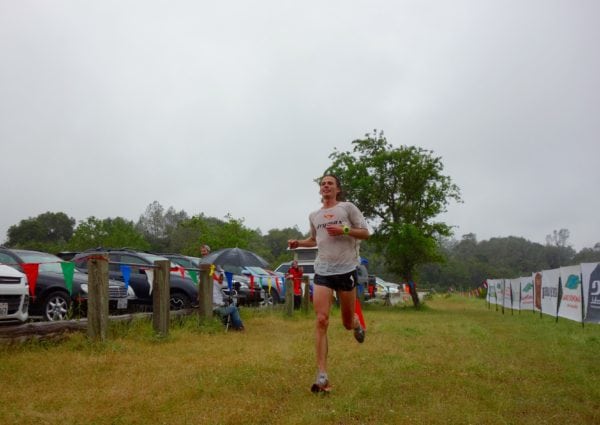Living in the Wasatch Mountains of Utah, I feel pretty lucky to live in a place with four solid seasons. My year is basically evenly split with three or four months of each. As the months roll along and the seasons change, so does my running wardrobe. That is one of the fun parts of being an all-season trail runner! My gear never feels old, used, or stale because I only use it for a few months before moving on to something else. My running drawers contain tights, capri pants, tank tops, long-sleeve shirts, jackets, half-zip shirts, running gloves, beanies, running hats, caps, base layers, sports bras, you name it!
When I look in my closet to pick out my clothes for a run, it is so nice to be able to evaluate the weather and then grab exactly what I need to stay comfortable. Here we will take an initial look the best kinds of clothes for various weather conditions so that, as the seasons come and go wherever you live, you can dress for success.
One thing we won’t be able to account for here is the duration of your run. Consider, however, that the longer your run is, the more important it is to dress appropriately for the weather. A five-mile run in the extreme heat or a downpour of rain is much different than a 20-mile run in those conditions, which is different, again, from a 50-mile run in the elements. Just like your hydration and nutrition become more important on longer runs, your running gear, too, becomes more crucial.
That said, if you are a new trail runner or a runner looking to venture into a new season with your sport, this article should provide you with the basic information you need to feel comfortable and be safe.

Long pants and one or two upper layers are appropriate clothing choices for a sunny but chilly mid-winter run in Park City, Utah. Photo: Rhielle Widders
First things first, I have a couple basic dressing rules:
Rule #1
Cotton is (almost always) your foe! Cotton makes for the most comfortable bed sheets and cozy sweats. However, cotton is hydrophilic, meaning it loves to soak up water. In fact, it can hold more than 20 times its weight in water. When you are shopping for running gear, seek out products made of fibers that dry quickly, or are hydrophobic. Examples of this are polyester, nylon, rayon, and more. Bear in mind that not all technical fibers are made equal. The $14 technical running shirt at the super center or warehouse club will be a step up from cotton but may not be comparable to the fibers used in the products from true athletic brands. It is more likely to rub your skin raw (ever heard of bloody nipples, gentlemen?) or to lose its shape in the washer or dryer. I am a complete running-apparel geek (notice how I call it apparel, not clothes), so I could write about the quality of fibers alone for an entire post. I won’t bore you with the details but bear in mind that you usually get what you pay for.
The exception to Rule #1 is the unusual situation in which you want to wear a garment that holds water for the water’s evaporative-cooling purposes. Runners out for long periods of time in extreme heat may find wearing a wet cotton t-shirt helpful. This is an exceptional circumstance.
Rule #2
Layers are your friends! Years ago I was working at the Salt Lake Running Company, a specialty-running store based out of Salt Lake City, Utah, and learned about what they call their “SVIP Layering System.” I have come to love this approach because it serves as a checklist that can be used when dressing for any type of weather.
S = Support
Are you wearing the best undergarment for the situation? For the ladies, this means the right sports bra made from the right material with the right fit. For the guys, this is underwear that is appropriate for the situation, especially applicable in colder weather.
V = Ventilation
This is the layer responsible for regulating heat and moisture transfer away from your body. Very crucial here is moisture transfer, as the body is more likely to maintain its temperature if your skin is dry. This piece is worn next to the skin.
I = Insulation
This layer will be most responsible for trapping heat and is, obviously, a crucial layer in cold weather.
P = Protection
This outermost layer protects from the elements like wind, water, and sun. Here you can also think about any other gear you may need to stay safe and protected, a headlamp or sunscreen, for example.
Armed with these two important rules, let’s take a look at the weather report and figure out how to dress for it.
Hot Temperatures
Dressing for hot weather can work to some extent but in extreme heat, avoiding the hottest times of the day will work better than any apparel. For the rest of the time, your clothing choices should focus on ventilation and protection.
Ventilate: Intuitively, you will likely wear loose-fitting clothing. In doing so, choose materials that wick sweat away from your body. Your skin will be heated and will produce sweat, and allowing that heat and sweat to be transferred away from your body, into the air moving around your body or through your clothing, will help you feel cooler. The goal in hot weather is not to stay dry, as that may be a virtual impossibility because of high sweat rates, but to wear clothing that transfers heat and moisture away from your skin, thereby helping you to feel cooler. Use care to choose materials that don’t chafe, as loose-fitting clothing will move about your skin.
Protect: Protect yourself from the sun’s energy-sapping effects and dangerous ultraviolet (UV) rays by wearing a running hat or visor, running sunglasses, sunscreen, and solar arm sleeves. To protect yourself from dehydration, be sure you carry water with you via a water bottle, backpack, running belt, or planned drinking fountains along the way.

Hats and long sleeves protect from the high-altitude sun in the San Juan Mountains, Colorado. Photo: iRunFar/Meghan Hicks
Cold Temperatures
As the Northern Hemisphere leans away from the sun for the next few months and the temperatures drop, it is time to layer up. Everyone’s cold tolerance is a bit different so I will share with you a formula that I heard once from a co-worker that seems to work wherever you live no matter what feels cold to you.
Step 1: Check the outside temperature.
Step 2: Add 20 degrees Fahrenheit (F) or 10 degrees Celsius (C) degrees to it.
Step 3: Dress for running like you would dress for that temperature in normal life. For example, if it is 25 degrees F (-4C) outside and you add 20 degrees F (10C), you end up with a total of 45 degrees F (6C). If you would wear a long-sleeve shirt and jeans to the grocery store in 45F (6C) weather, then long tights and a long-sleeve shirt should be appropriate for your run at 25F (-4C) as well. If you would wear a long-sleeve shirt with a jacket over the top, then make this your running outfit.
Layering up is a skill but with some practice it will become second nature. You likely won’t need all four layers in the SVIP Layering System on every single run. Similarly, different thicknesses and fabrics will affect how many layers are appropriate. No matter what, aim to under dress a little bit. It is much easier to run being a little bit cold than to overheat and start sweating. Sweat leads to wet, which leads to a quick and drop in core temperature. If you are in doubt about leaving home feeling a little under-dressed, tie an extra layer around your waist so you have it if you need it.
Support: Start with appropriate undergarments. Women lose the most heat through their thighs and glutes so ladies may add a pair of boy shorts-style underwear in when the temperature drops. Men may want to consider getting a pair of underwear with a front wind panel. This a feature I refer to as the ‘peter heater,’ and it has made many a men more comfortable on frigid, windy runs.
Ventilate: In the cold months, this is commonly known as a base layer. I prefer a fitted base layer so that it moves sweat away from my skin as quickly as possible. A fitted base layer also feels warmer to me–air that’s cooler than your body’s temperature circulating around your skin can transfer heat away and make you cold. The goal of your ventilation layer in the winter is to help keep you dry, so wearing a layer that wicks sweat away from your skin is crucial. Moisture on or against your skin will cool it faster.
Insulate: Get cozy! These pieces are fleecy or fluffy on the inside to trap heat and hold it in. This layer alone can work for a lot of runs in the winter. Running-appropriate insulation layers must still work if they become wet, whether it’s from moisture coming from the sky or moisture coming through your ventilation layer–obviously you want to avoid wetting your insulation layer but sometimes it’s impossible to avoid doing so. The best insulation layers for running will still work properly if damp and wick your sweat away from your body.
Protect: This layer can be windproof or waterproof to help protect against whatever element you face. In very cold weather, your protection layer also behaves as an additional insulator, too. A material that keeps wind and/or water out will also hold heat in. Be careful, however, as this type of jacket is only effective when the layers underneath are dry. If you start to sweat faster than your clothing can keep up with, strip off this layer, even temporarily, to cool off and keep the sweat rate low.
Accessorize! Don’t forget about beanies, gloves, and warmer socks. Having a cold head, fingers, or toes can lead to a dangerous situation with those extremities and/or a whole-body chill.
Precipitation and Humidity
We know that being wet means a decrease in body temperature. In warm or hot weather, this can be a great way to cool down. In the cold, however, being wet can quickly lead to discomfort and potential danger. And prolonged coldness is detrimental to performance. Depending on the environment and the duration/severity of the precipitation event, it may be impossible to stay dry while running. When that is the case, it’s important that you remain warm.
Rain/Sleet/Snow: If the water is falling from the sky, then a protection layer may be your best bet. Be careful how many layers are underneath your waterproof jacket, however. Wearing a piece with less breathability can lead to high sweat rates and being wet on the inside from sweat is just as bad as getting wet from the precipitation outside. If the weather is warm, your run is short, or it’s raining so much that keeping the rain out with a protective layer is impossible, consider other layers that will regulate your body temperature enough that you don’t become cold. Many trail runners opt for wool or wool-blend clothing when they expect to be wet, as wool has both ventilation and insulation properties. Something else to consider in wet weather is chafing via wet ventilation/base layers. If this is a concern, finding a ventilation layer that is fairly fitted and made of a material that doesn’t feel abrasive to your skin is important.

Gediminas Grinius wearing a light rain jacket in rainy, cool weather at the 2015 Ultra-Trail Mt. Fuji. Photo: iRunFar/Meghan Hicks
High Humidity: This is the one element that cuts comfort and performance no matter the air temperature. When water vapor is present in the air, it compounds the effects of temperature. In hot and humid weather, sweating becomes less effective as the evaporative cooling stops working. This results in a rapidly increasing core body temperature. In this situation, seeking out the coolest times of the day may be your best bet because clothing can only do so much to cool you down. In cold temperatures, humidity turns layering into a vital skill. The goal is that, as you sweat, layers come on and off to help keep the sweat rate low and your clothes and skin dry. In extreme cold and humidity, waterproof protective layers are a great way to trap heat in while keeping humidity out.

Jim Walmsley runs through rain in warm-enough temperatures that a jacket isn’t needed at the 2016 Lake Sonoma 50 Mile. Photo: iRunFar/Meghan Hicks
Wind
Wind is the hardest element in which I am asked to run. It is noisy and distracting and it inhibits performance without any sympathy. However, in the heat, the wind can be a welcome guest. When you are hot, the wind enhances the evaporative-cooling effect and can feel incredible. In the cold, however, layer up for comfort.
Insulate: Insulating against the cold with a heavier cozy layer may be enough to do the trick. Look for a piece that is fleecy and soft on the inside but smooth on the outside. This tight, closed exterior weave will help block a bit of the wind while the air space inside the fleece will help hold your body heat in.
Protect: Protect against the wind when it is really howling by adding a lightweight, wind-resistant outer layer. This doesn’t need to be very heavy to cut the wind out. My windproof jacket is feather light and works very well. When it is just barely warm but still windy, I wear it over a t-shirt to prevent overheating while staying protected against the driving force of the wind.
There you have it, the basics of how to dress in any weather. No more excuses or reasons to stay inside on a rainy day! Next time Mother Nature rears her head and sends storm clouds or heat waves your way, turn to your running wardrobe and pull out exactly what you need to hit the trails safely and comfortably.
Call for Comments (from Meghan)
- What features of your home climate do you need to dress for regularly? How do you dress for those conditions?
- What is your layering system for cold weather? Can you describe the layers and fabrics you use?
- In wet weather, what are the circumstances wherein you forgo trying to stay dry and instead make sure you stay warm even if you are wet?
- What are the most challenging kinds of weather for you when it comes to choosing clothes?

During unusual weather for Moab, Utah, Meghan Hicks runs at -15 degrees Fahrenheit (-26 Celsius) with all four layers: support, ventilation, insulation, and protection. Photo: iRunFar/Bryon Powell
